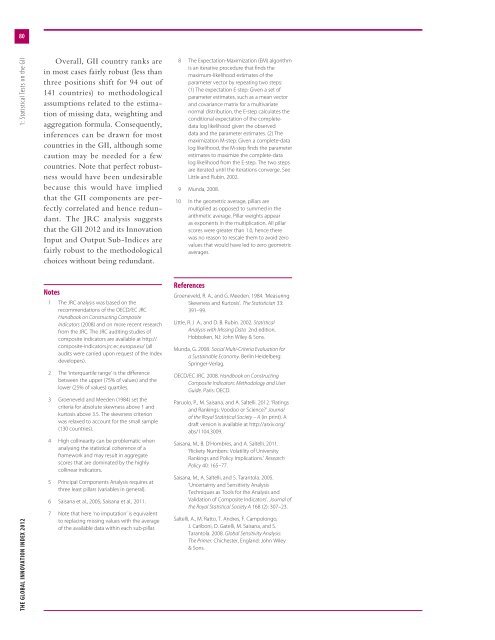The Global Innovation Index 2012
The Global Innovation Index 2012
The Global Innovation Index 2012
You also want an ePaper? Increase the reach of your titles
YUMPU automatically turns print PDFs into web optimized ePapers that Google loves.
80<br />
THE GLOBAL INNOVATION INDEX <strong>2012</strong> 1: Statistical Tests on the GII<br />
Overall, GII country ranks are<br />
in most cases fairly robust (less than<br />
three positions shift for 94 out of<br />
141 countries) to methodological<br />
assumptions related to the estimation<br />
of missing data, weighting and<br />
aggregation formula. Consequently,<br />
inferences can be drawn for most<br />
countries in the GII, although some<br />
caution may be needed for a few<br />
countries. Note that perfect robustness<br />
would have been undesirable<br />
because this would have implied<br />
that the GII components are perfectly<br />
correlated and hence redundant.<br />
<strong>The</strong> JRC analysis suggests<br />
that the GII <strong>2012</strong> and its <strong>Innovation</strong><br />
Input and Output Sub-Indices are<br />
fairly robust to the methodological<br />
choices without being redundant.<br />
Notes<br />
1 <strong>The</strong> JRC analysis was based on the<br />
recommendations of the OECD/EC JRC<br />
Handbook on Constructing Composite<br />
Indicators (2008) and on more recent research<br />
from the JRC. <strong>The</strong> JRC auditing studies of<br />
composite indicators are available at http://<br />
composite-indicators.jrc.ec.europa.eu/ (all<br />
audits were carried upon request of the <strong>Index</strong><br />
developers).<br />
2 <strong>The</strong> ‘interquartile range’ is the difference<br />
between the upper (75% of values) and the<br />
lower (25% of values) quartiles.<br />
3 Groeneveld and Meeden (1984) set the<br />
criteria for absolute skewness above 1 and<br />
kurtosis above 3.5. <strong>The</strong> skewness criterion<br />
was relaxed to account for the small sample<br />
(130 countries).<br />
4 High collinearity can be problematic when<br />
analysing the statistical coherence of a<br />
framework and may result in aggregate<br />
scores that are dominated by the highly<br />
collinear indicators.<br />
5 Principal Components Analysis requires at<br />
three least pillars (variables in general).<br />
6 Saisana et al., 2005; Saisana et al., 2011.<br />
7 Note that here ‘no imputation’ is equivalent<br />
to replacing missing values with the average<br />
of the available data within each sub-pillar.<br />
8 <strong>The</strong> Expectation-Maximization (EM) algorithm<br />
is an iterative procedure that finds the<br />
maximum-likelihood estimates of the<br />
parameter vector by repeating two steps:<br />
(1) <strong>The</strong> expectation E-step: Given a set of<br />
parameter estimates, such as a mean vector<br />
and covariance matrix for a multivariate<br />
normal distribution, the E-step calculates the<br />
conditional expectation of the completedata<br />
log likelihood given the observed<br />
data and the parameter estimates. (2) <strong>The</strong><br />
maximization M-step: Given a complete-data<br />
log likelihood, the M-step finds the parameter<br />
estimates to maximize the complete-data<br />
log likelihood from the E-step. <strong>The</strong> two steps<br />
are iterated until the iterations converge. See<br />
Little and Rubin, 2002.<br />
9 Munda, 2008.<br />
10 In the geometric average, pillars are<br />
multiplied as opposed to summed in the<br />
arithmetic average. Pillar weights appear<br />
as exponents in the multiplication. All pillar<br />
scores were greater than 1.0, hence there<br />
was no reason to rescale them to avoid zero<br />
values that would have led to zero geometric<br />
averages.<br />
References<br />
Groeneveld, R. A., and G. Meeden. 1984. ‘Measuring<br />
Skewness and Kurtosis’. <strong>The</strong> Statistician 33:<br />
391–99.<br />
Little, R. J .A., and D. B. Rubin. 2002. Statistical<br />
Analysis with Missing Data 2nd edition.<br />
Hobboken, NJ: John Wiley & Sons.<br />
Munda, G. 2008. Social Multi-Criteria Evaluation for<br />
a Sustainable Economy. Berlin Heidelberg:<br />
Springer-Verlag.<br />
OECD/EC JRC. 2008. Handbook on Constructing<br />
Composite Indicators: Methodology and User<br />
Guide. Paris: OECD.<br />
Paruolo, P., M. Saisana, and A. Saltelli. <strong>2012</strong>. ‘Ratings<br />
and Rankings: Voodoo or Science?’ Journal<br />
of the Royal Statistical Society – A (in print). A<br />
draft version is available at http://arxiv.org/<br />
abs/1104.3009.<br />
Saisana, M., B. D’Hombres, and A. Saltelli. 2011.<br />
‘Rickety Numbers: Volatility of University<br />
Rankings and Policy Implications.’ Research<br />
Policy 40: 165–77.<br />
Saisana, M., A. Saltelli, and S. Tarantola. 2005.<br />
‘Uncertainty and Sensitivity Analysis<br />
Techniques as Tools for the Analysis and<br />
Validation of Composite Indicators’. Journal of<br />
the Royal Statistical Society A 168 (2): 307–23.<br />
Saltelli, A., M. Ratto, T. Andres, F. Campolongo,<br />
J. Cariboni, D. Gatelli, M. Saisana, and S.<br />
Tarantola. 2008. <strong>Global</strong> Sensitivity Analysis:<br />
<strong>The</strong> Primer. Chichester, England: John Wiley<br />
& Sons.






